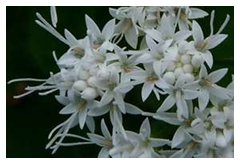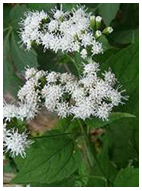By Dr. Christina Wilson and Kimberly Meyerholtz
 White snakeroot (Ageratina altissima) is a poisonous plant that is indigenous to the eastern part of North America. It is typically found in wooded areas, thickets or damp and shady pastures during mid-summer to late fall in Indiana. The toxicity of white snakeroot is thought to be attributed to the presence of the toxins tremetone, dehydrotremetone, and 2-oxyangeloyl-tremetone. This plant causes skeletal muscle necrosis and cardiotoxicity in livestock and grazing animals that ingest snakeroot at as little as 0.5-2% of their body weight. The plant toxins are also excreted in milk, therefore, suckling animals can also be susceptible to poisoning.
White snakeroot (Ageratina altissima) is a poisonous plant that is indigenous to the eastern part of North America. It is typically found in wooded areas, thickets or damp and shady pastures during mid-summer to late fall in Indiana. The toxicity of white snakeroot is thought to be attributed to the presence of the toxins tremetone, dehydrotremetone, and 2-oxyangeloyl-tremetone. This plant causes skeletal muscle necrosis and cardiotoxicity in livestock and grazing animals that ingest snakeroot at as little as 0.5-2% of their body weight. The plant toxins are also excreted in milk, therefore, suckling animals can also be susceptible to poisoning.
The onset of clinical signs in affected animals can occur within a few days to several weeks post-ingestion. Clinical signs of poisoning that are frequently observed can include weight loss, listlessness, constipation, dyspnea, salivation, acetone odor to the breath and urine (ketosis), muscle tremors or violent trembling, tachycardia or cardiac arrhythmias, and terminal collapse.
 The ADDL Toxicology Laboratory has a developed a diagnostic test for tremetone and dehydrotremetone in biological sam-ples from animals exposed to white snakeroot. In suspect cases of poisoning, the following samples can be submitted to the diagnostic laboratory for testing: Blood (EDTA), kidney, liver, plant material, serum, or rumen/stomach contents. The clinical signs, presence of white snakeroot in the hay or pasture, increased muscle enzymes (CK, ALP, and AST), cardiac or skeletal muscle degeneration on histopathology or identification of plant fragments in rumen or stomach contents are also supportive of a diagnosis of white snakeroot poisoning. Other differential diagnoses to consider include pesticide intoxication, ionophore toxicity, vitamin E/selenium deficiency, other poisonous plant exposure (e.g. rayless goldenrod, hairy vetch), exertional myopathies, or acute infectious diseases.
The ADDL Toxicology Laboratory has a developed a diagnostic test for tremetone and dehydrotremetone in biological sam-ples from animals exposed to white snakeroot. In suspect cases of poisoning, the following samples can be submitted to the diagnostic laboratory for testing: Blood (EDTA), kidney, liver, plant material, serum, or rumen/stomach contents. The clinical signs, presence of white snakeroot in the hay or pasture, increased muscle enzymes (CK, ALP, and AST), cardiac or skeletal muscle degeneration on histopathology or identification of plant fragments in rumen or stomach contents are also supportive of a diagnosis of white snakeroot poisoning. Other differential diagnoses to consider include pesticide intoxication, ionophore toxicity, vitamin E/selenium deficiency, other poisonous plant exposure (e.g. rayless goldenrod, hairy vetch), exertional myopathies, or acute infectious diseases.
Due to the high mortality of most cases, preventing exposure to white snakeroot is important. This includes limiting access to the plant and preventing consumption of raw milk from exposed animals.
- Lee St, Davis TX, Gardner Dr, Colegate Sm, Cook D, Green BT, Meyerholtz KA, Wilson CR et al:2010. Tremetone and structurally related compounds in white snakeroot (Ageratina altissima): A plant associated with trembles and milk sickness. J Agri Food Chem 58:8560-8565.
- Lee ST, Davis TZ, Gardner DR, Stegelmeier BL and Evans TJ: 2009. Quantitative method for the measurement of three benzofuran ketones in rayless goldenrod (Isocoma pluriflora) and white snakeroot (Ageratina altissima) by high-performance liquid chromatography (HPLC). J Agri Food Chem 57:5639-5643
- Meyerholtz KA, Burcham GN, Miller MA, Wilson CR, Hooser SB, Lee ST: 2011. Development of a gas chromatography-mass spectrometry technique to diagnose white snakeroot (Ageratina altissima) poisoning in a cow. J Vet Diag Invest 23:775-779.
- United States Department of Agriculture, Natural Resources Conservation Service, http://plants.usda.gov
- Zoltani CK: 2012. In: Veterinary Toxicology: Basic and Clinical Principles. R. Gupta (editor) Elsevier, Inc., San Diego, CA, pp. 235-245.